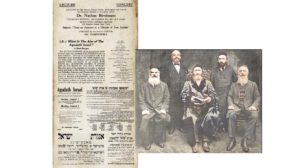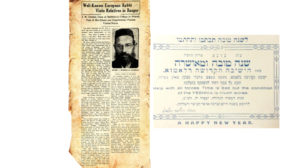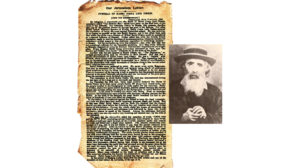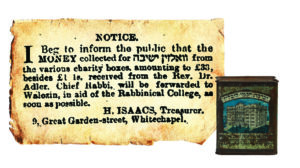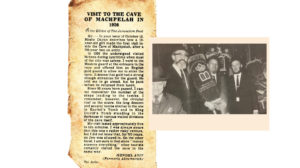Buried Treasures
| November 18, 2020Rabbi Moshe Bamberger unveils hidden greatness in the cemetery
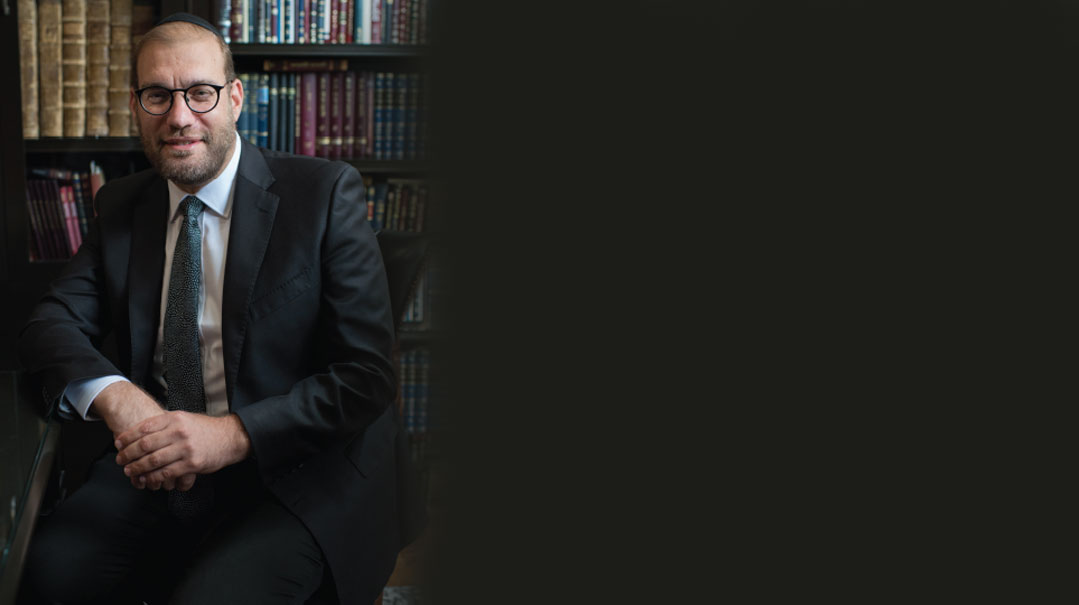
How interesting could a book about graves be?
Just ask Rabbi Moshe Bamberger, mashgiach ruchani at Lander College for Men in Kew Garden Hills, Queens, and he’ll tell you that there’s a lot more to a cemetery than earth and tombstones.
“When someone visits a grave, there’s always a lesson they can take away from the niftar,” he says. Especially if that person was a gadol or important Torah personality.
Rabbi Bamberger, author of the Great Jewish book series, wants to bring those takeaways to everyone. He’s about to launch the seventh book of the series, but this one is more than just a graphic presentation of Jewish history. Great Jewish Journeys is also a travelogue of hard-to-find kivrei tzaddikim and little-known, fascinating snippets of their lives, and it’s filled with photographs, biographies, fragments of inspiration, and even custom-designed maps for those who actually want to follow along with their feet.
The entire Great Jewish series started — as many great things do — quite by accident, when, back in 2008, as Rabbi Bamberger was trying to decide on a year-long topic for his weekly class, he remembered the fascinating letters from gedolim that he’d come across over the years.
“Many of us know the intellectual side of these great Torah personalities, but the letters show another angle that most have never seen,” he says. “It’s the emotional, pull-at-your-heartstrings side that you can see in the letters they penned to their families and students.”
Rabbi Bamberger — who attributes his love for Judaica to his father a”h, a collector of Jewish books, artifacts, and manuscripts — decided to discuss a different letter every week, and the class became increasingly popular. “Why don’t you publish this?” some students asked, pointing out that the course material would make a great book.
Rabbi Bamberger approached ArtScroll founder Rabbi Meir Zlotowitz a”h, who, ever the visionary, signed on it right away. The following year, Great Jewish Letters was published as a lavish, full-color coffee table book.
“That first book gave me a taste of what could be,” explains Rabbi Bamberger. “There were definitely more angles than just their letters from which to explore the great rabbinic personalities of Jewish history.”
And so, he went on to write Great Jewish Speeches in 2011, followed in 2014 by Great Jewish Wisdom — a book of profound and penetrating quotes; Great Jewish Treasures in 2015 — a collection of precious, and surprising Judaica belonging to gedolim over the centuries; Great Jewish Classics in 2017, covering the history and influence of important Torah works; and Great Jewish Photographs in 2019. In 2020, Rabbi Bamberger launched the Great Jewish Broadcast, a weekly WhatsApp broadcast of photos, artifacts, videos, and more, which are shared with nearly 5,000 people.
“We’re a generation of emotion, of love and feeling as opposed to pure intellect,” Rabbi Bamberger says. “So there’s a thirst for a more complex understanding of the gedolim.” These books, he feels, fill that need, giving readers another avenue of connection with Jewry’s leaders throughout the generations.
“The series is about finding the beauty in facets of their lives people didn’t know about previously. We know most rabbis for their scholarship and brilliance alone,” he continues. “I wanted to help people understand the gedolim in a way we never understood them.”
One such example is a letter Rabi Akiva Eiger wrote soon after his wife passed away. Two askanim had suggested a shidduch for him, and Rabi Eiger explained he was shocked at the notion that his eishes chayil could be so easily replaced. “Do you know what she was to me?” he wrote back, describing the beautiful relationship between them and describing how the two often spoke about spiritual matters until midnight.
“After I published the letter, readers wrote to me that they never knew this part of the gadol,” Rabbi Bamberger shares. “But the letter doesn’t diminish his greatness — it just brings a new light to his tremendous compassion and sensitivity.”
Great Jewish Journeys was actually an unintentional offshoot of Great Jewish Treasures, a book on Jewish artifacts. After the book was printed in 2015, a certain scholar approached Rabbi Bamberger and told him, “You left out major Jewish artifacts!”
“Which ones?” Rabbi Bamberger asked. The man explained that Jewish landmarks and cemeteries throughout the world are really living artifacts, ones that deserved to be documented and remembered.
“It was a lightbulb moment,” says Rabbi Bamberger. “I thought to myself, What if we made a book about these destinations to the past?” Great Jewish Journeys was then conceived, with about 80 percent of the book being about kevarim. There are also dedicated sections for each city’s major Jewish addresses.
Many of the chapters in the book come with an accurately drawn cemetery map so people can use the book as a travel guide. “It’s hard to find a lot of these graves on your own,” Rabbi Bamberger says, pointing out that many are hidden in dilapidated cemeteries with no modern markers. “I envision people using the book to find the kevarim, opening to the page, and reading about the tzaddik’s life.” Cartography was one of the biggest production expenses, but, says Rabbi Bamberger, worth every penny.
The seeds of the project were planted decades ago, when Rabbi Bamberger first began visiting European kevarim with his father. But the real work took place over the last year, when “the wonderful team at ArtScroll made it happen.”
Rabbi Bamberger narrowed the focus of each chapter to either an end-of-life story for each person, something that happened after they passed away, a teaching they shared about life and death, or an interesting epitaph that caught his attention.
“It was a challenge to choose what to include,” he admits, “but overall, I tried to make each page a seamless package of the most interesting stories or tidbits that tell the tale in a different way.”
For example, when documenting the Ohel of Lubavitch in Queens’ Montefiore Cemetery, where both Rebbe Yosef Yitzchak Schneerson (the previous Rebbe, known as the Rayatz) and Rebbe Menachem Mendel Schneerson are buried, Rabbi Bamberger included the previous Rebbe’s near-death episode in a Soviet prison. When guards threatened the Rayatz with a gun, he told them that he was not afraid: “A gun is only a threat to a person with a single world and many G-ds,” he said. “But for someone with many worlds and only one G-d, the prospect of a gun isn’t frightening.”
The choice of messages on each page is deliberate, says Rabbi Bamberger. “I wanted to make sure that when people go to that grave, they can use the book for ideas of ‘V’hachai yiten el libo — a lesson to take away from that particular person.’”
There’s a special story Rabbi Bamberger discovered about Sephardic leader Rav Ovadiah Yosef and his wife, Margalit, whose tombstones share a spread in Journeys. “When the shidduch was proposed, Rav Ovadiah went to the house to speak with his prospective father-in-law and then meet Margalit,” Rabbi Bamberger recounts. “Rav Ovadiah had a genius mind and was able to marshal myriad sources by heart. So, when he and his potential father-in-law discussed their learning, the conversation kept going and going.”
Meanwhile, Margalit was in her room, wondering what was going on. The young man had come to meet her, not her father — why were they keeping her waiting? After hours passed, during which Margalit grew more and more frustrated, her father noticed the time. “It’s too late — you can’t meet my daughter today,” he told Rav Ovadiah. “Please come back tomorrow.”
When Margalit heard that she wouldn’t meet the prospective chattan that night, she was understandably upset. “Don’t worry,” her father appeased her. “When he comes tomorrow, we won’t get sidetracked with Torah discussions.” Rav Ovadiah returned the next day and Margalit’s father kept his word — until he offered the young man a cup of tea. Was the cup of tea too hot to make a brachah acharonah? The men disagreed. And from there, they launched into a halachic debate that would last for hours.
When yet another night ended, Margalit decided that she was done giving Rav Ovadiah chances. The shidduch was clearly not meant to be. After a bit of convincing from her father, she agreed to give Rav Ovadiah just five minutes of her time. When the couple returned from their short conversation, they announced their engagement. Margalit’s father was surprised. What had Reb Ovadiah said that made her change her mind so quickly?
“I told her that if she’ll take care of my olam hazeh, I’ll share my olam haba with her,” Rav Ovadiah confided.
In the book, this story is written alongside a picture of Rav Ovadiah and Margalit’s kevarim, which are side by side in Jerusalem’s Sanhedria cemetery.
“It’s definitely an end-of-life story,” says Rabbi Bamberger.
One of the clearest indicators of a person’s life is what’s said about him once he passes on. Rabbi Bamberger pored over hundreds of epitaphs, deciphering the messages often hidden inside. Rabi Akiva Eiger’s tombstone, for example, could have lauded his brilliance. Instead, all it says is, “Here is buried Harav Rabbeinu Akiva Eiger, eved l’avdei Hashem.”
“It tells you a lot about how he looked at himself — he didn’t see himself as a leader. He saw himself as nothing more than a servant to the servants of Hashem. It sums up how he lived his life. He wanted to serve the Jewish community in any capacity that he could,” says Rabbi Bamberger. “I absolutely love that line.”
Rav Yosef Karo’s epitaph is similarly telling. “You would think that the Beis Yosef’s tombstone would have a long, elaborate paragraph. After all he was a great leader and the author of many classic works. But in fact, all it says is one simple line: ‘Harav Rabi Yosef Karo, author of the Shulchan Aruch.’ It’s interesting, but not surprising because it’s known that while Rav Yosef Karo was working on the Shulchan Aruch, several scholars wrote similar seforim also codifying Jewish law. Yet Rav Yosef Karo’s became the standard. He has the zechus to have his volumes on shelves in virtually every Jewish home, and we have a mesorah that he earned this merit through his great humility. If you think about it, it’s perfectly fitting that his epitaph is just that — utter simplicity and modesty.”
Because there are countless landmarks that could be included in the book, Rabbi Bamberger narrowed it down to the most prominent gedolim or the landmarks and graves that have a remarkable story. At 408 pages, Great Jewish Journeys is the largest in Rabbi Bamberger’s series — and for every page that’s printed, there are three or four that didn’t make it past the drafts.
The Izaak Synagogue in Krakow is one of the landmarks left behind. The legend of the shul centers around Izaak, a poor man who once had a dream: If he went to Prague, the dream told him, he would find a great treasure under the old bridge.
Izaak begged, borrowed, and pleaded until he got enough money to travel to Prague, then he took a shovel and started digging beneath the bridge. When a guard stopped him, Izaak explained his dream — at which the guard was astonished. The guard had been having a similar dream too, but in his dream, the guard was told that a poor man named Izaak of Krakow had a treasure buried in his own backyard! With that, Izaak picked up his shovel and returned to his home in Krakow. He did indeed find the treasure, which he used to build a great shul for the community.
“It’s a metaphor for life,” says Rabbi Bamberger. “We’re looking for treasures yet they’re right here under our noses.” Rabbi Bamberger saw the truth in that when tracking down the original of a certain letter for his first book. “I turned over heaven and earth to find a copy. I was calling people in Eretz Yisrael, who were connecting me to other leads, who then couldn’t find the letter — one step after another. I was literally looking all over the world, and then I found out that someone who lives a block away from my office had the original manuscript in his house! We don’t have to go searching the entire world for a better tomorrow,” he extrapolates. “We have so much treasure already.”
The same rings true when it comes to visiting kevarim — some of the greatest landmarks are literally around the corner.
“Ten minutes away from my home in Queens is the kever of Rabbi Yaakov Yosef, the first chief rabbi of New York, who led a very interesting but turbulent life, as well as the kevarim of the great roshei yeshivah of Torah Vodaath — Rav Shlomo Heiman, Rabbi Yaakov Kamenetsky, and Rav Avrohom Pam. There’s the Ohel of the Rebbes of Lubavitch, and the Chofetz Chaim’s second rebbetzin is buried there as well. People travel to Europe and to Eretz Yisrael to daven at kivrei tzaddikim, which is laudable, but they don’t realize that they have special kivrei tzaddikim so close by.”
Unfortunately, countless kevarim have been victims of the ravages of time and history. We have no idea where they are or how to find them. There are some lost landmarks, however, that Rabbi Bamberger was still able to include — because even if the kever is no longer standing, we know the precise location of where it should be. One such kever is that of Rav Yosef Dov Soloveitchik, the Beis Halevi, in Brisk.
Rav Meshulum Dovid Soloveitchik, rosh yeshivah of Brisk in Jerusalem, knew the exact spot — he’d grown up in Brisk and knew the area well. When a delegation stumbled upon the mikveh used for taharos, which Rav Meshulum Dovid said was nearby, they knew that they’d found the cemetery. The Beis Halevi, his wife, children, and many other Brisker leaders are buried there.
But today, the area is part of a local gymnastic stadium.
The kevarim of the great Brisker community have since been paved over.
“It’s very sad,” says Rabbi Bamberger, sharing that the Chabad shaliach in Brisk, modern-day Brest, graciously went to the stadium and took photos of the area for the book. “At least we have that.”
One kever that holds personal meaning for Rabbi Bamberger is the grave of his own rebbi and teacher, Rav Shlomo Zalman Auerbach, the great Yerushalmi posek and rosh yeshivah of Kol Torah. “He was always positive, princely, and overwhelmingly brilliant. As a talmid I was enamored by him,” Rabbi Bamberger shares. “When I once went to visit his kever on Har Hamenuchos, his son Rav Shmuel Auerbach was there, so I stood back to wait for him to finish davening. It was fascinating. His father was a towering giant and everyone clamors to daven at his grave, but when Rav Shmuel turned toward his mother’s kever — that’s when he sobbed like a child. Rav Shmuel was a grown man, one of the leading rabbanim of his generation, and it was his mother’s grave that brought all this emotion out of him.”
The moment stuck with Rabbi Bamberger and guided him as he wrote the book. “Especially after seeing Rav Shmuel daven at his mother’s kever, it became very important to me to feature as many women as possible.”
Rachel Imeinu, the mother of the Chasam Sofer, Sarah Schenirer, and Sulika Hachuel each has a chapter. If there were room, he would have included even more.
“There’s a Midrash [Midrash Tehillim, chapter 20] that brings a mashal of a father and son walking on the road,” Rabbi Bamberger says. In the Midrash, the son was getting tired from the travels and asked his father, “Are we almost there yet?”
“Siman zeh yihiyeh b’yadecha — take this as a sign,” his father answered. “As soon as you see a cemetery before you, it means that the city is right there.”
The medrash brings the story as a mashal for Klal Yisrael, Rabbi Bamberger explains. “Hashem is saying to us, ‘My sons, if you see that the tzaros are overwhelming you — as represented by the cemetery — know that at that exact hour you will be redeemed from galus.’ When our lives are filled with pain it means that the time for geulah is close by.
“People are naturally afraid of cemeteries and death,” Rabbi Bamberger continues. “We’re scared to face our mortality — it’s frightening and difficult. In the context of this book, I think the Midrash means that when we look death in the face and internalize that it’s a part of our destiny, whether we like it or not, we reach a point of personal redemption. Recognizing death brings us to a certain maturity, and a deeper understanding of one’s mission in life. As Aish HaTorah founder Rabbi Noach Weinberg used to say, ‘Until you know what you’re willing to die for, you haven’t really begun to live.’”
When we study the people who have passed on, when we take lessons from their lives and from their deaths, it brings us closer to the city we’re trying to reach. It brings us closer to our own geulah.
(Originally featured in Mishpacha, Issue 836)
Oops! We could not locate your form.
